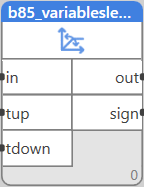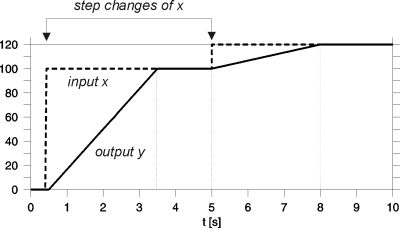Table of Contents
Ramp with a constant time of change
Block name
B85_VARIABLESLEWRATELIMIT
ST call
PROGRAM TEST B85 VAR REAL1,REAL2 : REAL; FB : LIB.CORE.V1_0.B85_VARIABLESLEWRATELIMIT; END_VAR FB(IN:=REAL1, TDOWN:=T#3S ,TUP:=T#3S,OUT=>REAL2); END_PROGRAM
Library
LIB\CORE
Version
V1.0
Description
The block prevents the signal from rapid changes. The output change is recalculated to travel over a constant time of signal rise (Tup) or fall (Tdown).
Inputs
| Input | Type | Description | Default value |
| IN | REAL | Input signal | 0 |
| TDOWN | TIME | Fall time | 30s |
| TUP | TIME | Rise time | 30s |
Outputs
| Output | Type | Description |
| OUT | REAL | Filtered output signal |
| BS | BOOL | Sign of the output signal |
| NBS | BOOL | Negated sign of the output signal |
Function
The block converts the input in to the output out with time delay as follows: every falling change at in causes a linear decline out=in in time of Tdown. The same is for a rising signal at in: it causes linear rise of y so that out=in in Tup time, see Fig. below. Each signal travel direction is thus controlled separately.
If Tdown=0 then any falling edge of in is transferred immediately to out, accordingly for the rising signal and Tup=0. At program start, the input in is copied to the output.
The output sign indicates the sign of the output signal out. If y>= 0 then sign=true, otherwise sign=false.
Function in case of wrong setting
If Tdown⇐ 0 then Tdown=0, if Tup⇐ 0 then Tup=0.
B85 Situation for Tup=3s. Note that the time of change is equal to Tup for any change of the input in.
Application example
The block is used for slow opening of valves at steam heat exchangers. The falling time is 0 so that the valve shuts down immediatelly according to the PI controller, while the rising time may be several minutes for the valve to open slowly even if the controller gives fast output response. This is to prevent rapid changes of pressure and temperature in the exchanger piping.


